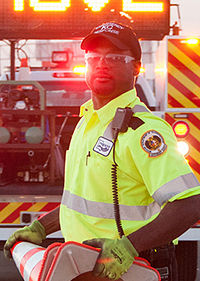Category:910 Intelligent Transportation Systems

| Nonstandard JSP Available for ITS |
| Work Zone Intelligent Transportation System |
An Intelligent Transportation System (ITS) encompass a broad range of information, control and electronics technologies for managing surface transportation such as roads and bridges. When integrated into the roads and vehicles, these technologies help monitor and manage traffic flow, reduce congestion, provide alternate routes to travelers, enhance productivity and save lives, time and money.
Intelligent transportation systems allow skilled transportation professionals to collect and react to data about the performance of the system. One of ITS’s primary benefits is that much of the data is current, or "real time". Having this real time data enhances traffic operators' ability to respond to incidents, adverse weather or other capacity constricting events.
A Traffic Management Center is one type of ITS. Missouri has three such centers, Scout in Kansas City, Gateway Guide in St. Louis and Ozarks Traffic in Springfield. These centers monitor the roadways, respond to congestion and incidents and deliver information to travelers via a number of means, including web sites, dynamic message signs and highway advisory radio.
An ITS Architecture Package is available to document a framework assisting coordination of future ITS planning, deployment and operations activities for Missouri.
New ITS applications and technologies are being developed every day. MoDOT will continue to apply these where possible to improve driving in Missouri. Traffic incidents and congestion take a heavy toll in lives, lost productivity and wasted energy. ITS enables people and goods to move more safely and efficiently.
910.1 The Need for ITS
ITS is needed to better manage the growing amount of traffic on Missouri's roadways. Cost, space and environmental concerns limit MoDOT's ability to add more pavement. By using ITS, the use of our existing road system is maximized. Incidents on the road can easily tangle traffic:
- 1 minute of lane blockage = 5 minutes of traffic congestion
- During peak hours, 1 minute of lane blockage can cause about 20 minutes of traffic congestion.
- A vehicle on the shoulder of the road reduces the capacity of the closest lane by 20 percent.
- Approximately 60 percent of congestion is caused by incidents.
910.2 How ITS Works

ITS is comprised of many components that, when combined, effectively fight traffic congestion.
- Fiber-optic cables communicate information between monitoring devices and the MoDOT Traffic Operations Center.
- Sensors provide information on average traffic speed and volume.
- Closed-circuit cameras at major interchanges, intersections and river bridge crossings provide live video information on traffic flow.
- Permanent mounted variable message signs inform motorists of incidents ahead and supply alternate route options.
- Highway Advisory Radio signs equipped with lights that flash when there is new traffic information.

- Integration of regional/urban traffic signal systems.
- The toll-free cellular call-in system routed to the MoDOT Traffic Operations Center or the Missouri Highway Patrol for immediate response to incidents.
- Improved highway mile markers identify exactly where a motorist is to accurately pinpoint the location of incidents.
- In Kansas City and St. Louis, Emergency Response helps stranded motorists to get their vehicles out of traffic lanes and, if possible, running again.
- Advanced Traveler Information on weather conditions, incidents and traffic congestion levels.
- Direct media tie-in to traffic information for broadcast to motoring public.
- Direct emergency services tie-in for immediate response to incidents.
- Sharing information with transit centers regarding traffic flow.
- In urban areas, ramp-metering smoothes traffic flow on the highway near entrance ramps.

Articles in "910 Intelligent Transportation Systems"
The following 4 pages are in this category, out of 4 total.